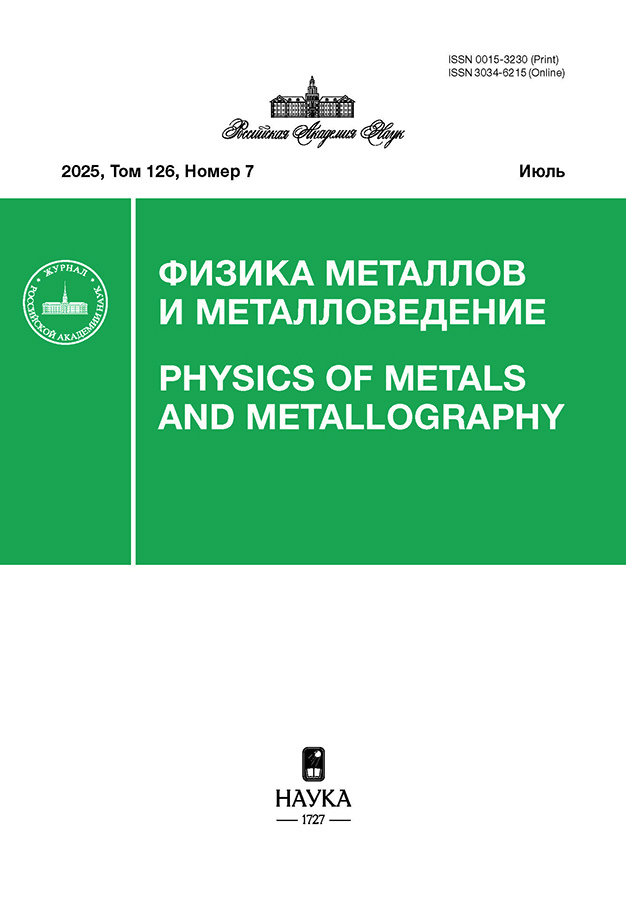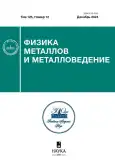Исследование остаточных напряжений в стальных пластинах после дробеударной обработки методом дифракции нейтронов высокого пространственного разрешения
- Авторы: Карпов И.Д.1, Эм В.Т.1, Николаева Е.П.2, Сергеичев И.В.3, Волосков Б.С.3, Микула П.4
-
Учреждения:
- Национальный исследовательский центр “Курчатовский институт”
- Иркутский национальный исследовательский технический университет
- Сколковский институт науки и технологий, Центр технологий материалов
- Nuclear Physics Institute CAS
- Выпуск: Том 125, № 12 (2024)
- Страницы: 1675-1684
- Раздел: ПРОЧНОСТЬ И ПЛАСТИЧНОСТЬ
- URL: https://journal-vniispk.ru/0015-3230/article/view/283850
- DOI: https://doi.org/10.31857/S0015323024120208
- EDN: https://elibrary.ru/IHKWTC
- ID: 283850
Цитировать
Аннотация
Методом дифракции нейтронов с высоким пространственным разрешением (~0.2 мм) исследованы остаточные напряжения в пластинах из конструкционной легированной (Cr, Si, Mn) стали толщиной 5 мм после дробеударной обработки. Показано, что остаточные напряжения образуются не только вблизи обработанной поверхности, а по всей толщине пластины. Зоны сжимающих напряжений образуются вблизи обработанной и необработанной поверхностей пластин, а зона растягивающих напряжений — в средней части. Интенсивность дробеударной обработки влияет на ширину зон и величину максимальных напряжений. Проведены нейтронные эксперименты по измерению напряжений вблизи обработанной поверхности пластин с использованием метода sin2ѱ. Результаты согласуются с результатами, полученными традиционным методом измерения трех компонент деформации. Нейтронный метод sin2ѱ может быть использован для измерения напряжений вблизи поверхности образцов большой толщины, поскольку в отличие от традиционного метода не имеет принципиальных ограничений по толщине образца.
Ключевые слова
Полный текст
Об авторах
И. Д. Карпов
Национальный исследовательский центр “Курчатовский институт”
Email: vtem9@mail.ru
Россия, Москва
В. Т. Эм
Национальный исследовательский центр “Курчатовский институт”
Автор, ответственный за переписку.
Email: vtem9@mail.ru
Россия, Москва
Е. П. Николаева
Иркутский национальный исследовательский технический университет
Email: vtem9@mail.ru
Россия, Иркутск
И. В. Сергеичев
Сколковский институт науки и технологий, Центр технологий материалов
Email: vtem9@mail.ru
Россия, Москва
Б. С. Волосков
Сколковский институт науки и технологий, Центр технологий материалов
Email: vtem9@mail.ru
Россия, Москва
П. Микула
Nuclear Physics Institute CAS
Email: vtem9@mail.ru
Чехия, Řež
Список литературы
- Prevéy P.S. X-ray Diffraction Residual Stress Techniques // Metals Handbook. 10. Metals Park: American Society for Metals. 1986. P. 380–392.
- Prevey P.S. X-Ray Diffraction Characterization of Residual Stresses Produced by Shot Peening. Lambda Research Inc., 1111 Harrison Avenue, Cincinnati, OH 4.5214. 2001. P. 81–93.
- Николаева Е.П., Гридасова Е.В., Герасимов В.В. Применение рентгеноструктурного анализа и шумов Баркгаузена для исследования конструкционной стали 30ХГСА после дробеударной обработки // Изв. Самарского научного центра Российской академии наук. 2007. Т. 17. № 2. C. 125–132.
- Santana Y.Y., Renault P.O., Sebastiani M., La Barbera J.G., Lesage J., Bemporad E., Le Bourhis E., Puchi-Cabrera E.S., Stai M.H. Characterization and residual stresses of WC–Co thermally sprayed coatings // Surf. Coat. Technol. 2008. V. 202. P. 4560–4565.
- Moore M.C., Evans W.P. Mathematical Corrections for Stress in Removed Layers in X-ray Diffraction Residual Stress Analysis // SAE Trans. 1958. V. 66. P. 340–345.
- Hutchings M.T., Withers P.J., Holden T.M., Lorentzen N. Introduction to the characterization of residual stress by neutron diffraction. 1-st ed. Tailor and Francis. London, 2005. 434 p.
- Ezeilo A., Webster G., Webster P.J., Webster P.S. Comparison of shot peening residual stress distributions in selection of materials / in: D. Kirk (Ed.). International Conference on Shot Peening, Christ Church, Oxford University. UK, 1993. P. 274–281.
- Webster P.J., Mills G., Wang X.D., Kang W.P., Holden T.M. Impediments to efficient through-surface strain scanning // J. Neutron Research. 1996. V. 3. P. 223–240.
- Evans A.D., King A., Pirling T., Bruno G., Withers P.J. Near surface residual stress determination of laser shock peening by neutron diffraction // J. Neutron Research. 2003. V. 1. № 4. P. 229–233.
- Bruno G., Fanara C., Hughes D.J., Ratel N. Procedures for interface residual stress determination using neutron diffraction: Mo-coated steel gear wheel // Nuclear Instruments and Methods in Physics Research B. 2006. V. 246. P. 425–439.
- Šaroun J., Rebelo Kornmeier J., Hofmann M., Mikula P., Vrana M. Analytical model for neutron diffraction peak shifts due to the surface effect // J. Appl. Crystallogr. 2013. V. 46. P. 628–638.
- Rebelo Kornmeiera J., Hofmann M., Luzin V., Gibmeierd J., Saroune J. Fast neutron surface strain scanning with high spatial resolution // Mater. Characterization. 2019. V. 154. P. 53–60.
- Menig R., Pinsshovius L., Shulze V., Vohringer O. Depth profiles of macro residual stresses in thin shot peened steel plates determined by X-ray and neutron diffraction // Scripta Mater. 2001. V.45. P. 977–983.
- Luzin V., Vackel A., Valarezo A., Sampas S. Neutron Through-Thickness Stress Measurements in Coatings with High Spatial Resolution // Mater. Sci. Forum. 2017. V. 905. P. 165–173.
- Pirling T., Bruno G., Withers P.J. SALSA - A new instrument for strain imaging in engineering materials and components // Mater. Sci. Eng.: A. 2006. V. 437. P. 139–144.
- Hofmann M., Schneider R., Seidl G.A., Rebelo-Kornmeier J., Wimpory R.C., Garbe U., Brokmeier H.G. The new materials science diffractometer STRESS-SPEC at FRM-II // Physica B: Condensed Matter. 2006. V. 385–386. Part 2. P. 1035–1037.
- Kirstein O., Luzin V., Garbe U. The strain-scanning diffractometer Kowari // Neutron News. 2009. V. 20. P. 34–36.
- Luzin V., Spiridonov P., Spencer K., Gnaupel-Herold T. Neutron Diffraction Study of Macrostress and Microstress in Al–Al2O3-Based Corrosion Protection Coating Obtained by Cold Spray (Dynamic Metallization) // J. Therm. Spray Techn. 2020. V. 29. № 6. P. 1437–1454.
- Meghwal F., Berndt C.C., Luzin V., Schulz C., Crowe T., Gabel H. ASM Ang, Mechanical performance and residual stress of WC–Co coatings manufactured by Kinetic Metallization // Surf. Coat. Tech. 2021. V. 421. Р. 127359.
- Withers P.J., Johnson M.W., Wright J.S. Neutron strain scanning using a radially collimated diffracted beam // Phys. B. 2000. V. 292. P. 273–285. https://doi.org/10.1016/S0921-4526(00)00481-6
- Reid M., Olsen S., Luzin V., New M., Booth N., Clowes D., Nguyen T., Franceschini F., Ogrin A., Pangalis S., Paradowska A., Larkin N., Pan Z., Hoye N., Suzuki H. Neutron optics upgrades to the residual stress diffractometer, KOWARI // Mater. Research Proceedings. 2016. V. 2. P. 371–376.
- Noyan I.C., Cohen J.B. Residual Stress. Measurement by Diffraction and Interpretation, Springer-Verlag. New York, Berlin, Heidelberg, 1987. 276 p.
- Hauk V.M., Oudelhoven R.W.M., Vaessen G.J.H. The State of Residual Stress in the Near Surface Region of Homogeneous and Heterogeneous Materials after Grinding // Metal. Trans. 13A. 1982. P. 1239–1244.
- ISO 21432:2019 Non-destructive testing — Standard test method for determining residual stresses by neutron diffraction. ISO. Geneva. Switzerland. 2019. 45 p.
- Эм В.Т., Балагуров А.М., Глазков В.П., Карпов И.Д., Mikula P., Мирон Н.Ф., Соменков В.А., Сумин В.В., Saroun J., Шушунов М.Н. Двойной монохроматор для нейтронной стресс-дифрактометрии // ПТЭ. 2017. № 4. C. 75–81. [Em V.T., Balagurov A.M., Glazkov V.P., Karpov I.D., Mikula P., Miron N.F., Somenkov V.A., Sumin V.V., Šaroun J., Shushunov M.N. A double-crystal monochromator for neutron stress diffractometry // Instr. exper. techn. 2017. V. 60. № 4. P. 526–532.]
- Em V.T., Karpov I.D., Somenkov V.A., Glazkov V.P., Balagurov A.M., Sumin V.V., Mikula P., Šaroun J. Residual stress instrument with double-crystal monochromator at research reactor IR-8 // Physica B: Condensed Matter. 2018. V. 551. P. 413–416.
Дополнительные файлы


















